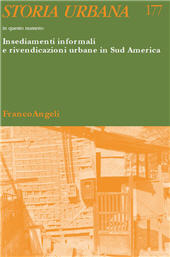Tra informalità e mobilitazione : le occupazioni di terreno a Santiago del Cile, 1954-ÂÂ1973
59-78 p.
Le occupazioni di terreno, conosciute in Cile come tomas, sono state strategie informali di insediamento, oppure le azioni più emblematiche di un movimento sociale urbano, quello dei pobladores? L'ipotesi sviluppata nell'articolo suggerisce che, sebbene le occupazioni siano da intendere come azioni complesse, mosse da molteplici obiettivi, nel caso cileno sia prevalsa la componente rivendicativa. Quindi, possono essere studiate come eventi di protesta. Attraverso una ricognizione degli articoli apparsi sulla stampa del tempo e sulle fonti d'archivio, è stato possibile ricostruire una serie omogenea di occupazioni realizzate a Santiago tra il 1954 e il 1973, che sono state analizzate al fine di comprendere quali attori parteciparono e che rapporti stabilirono con il sistema istituzionale e politico. Si è potuto constatare che le tomas furono sensibili ai cambiamenti del contesto. Tra il 1954 e il 1970 sono stati identificati un centinaio di eventi.
Anche in conseguenza di una dura repressione, le occupazioni riuscirono a formare insediamenti in poche occasioni, ma furono efficaci nell'influenzare le politiche pubbliche. Invece, tra il 1970 e il 1973, l'atto di occupare perse visibilità, ma divenne molto efficace nel creare insediamenti. Nonostante queste modalità diverse, attraverso le occupazioni i pobladores riuscirono a conquistare un posto nella città, anche se periferico e riuscirono a conquistare dei diritti, anche se incompleti. [Testo dell'editore].
Were land occupations, known in Chile as tomas, informal strategies of settlement, or the most emblematic actions of an urban social movement, that of the pobladores? Our hypothesis is that, although occupations are to be understood as complex actions, driven by multiple goals, in the Chilean case the claim ÂÂmaking component prevailed. Thus, they can be studied as protest events. Through a review of press and archival sources, we reconstructed a homogeneous series of occupations carried out in Santiago between 1954 and 1973, which were analyzed in order to understand which actors participated and what relationships they established with the institutional and political system. We could verify that the tomas were sensitive to changes in the context. Between 1954 and 1970 we identified about 100 events. Partly as a result of harsh repression, the occupations achieved to establish settlements on a few occasions, but were effective in influencing public policy.
In contrast, between 1970 and 1973, the act of occupying lost visibility but became very effective in creating settlements. Despite these different dynamics, through the occupations the pobladores managed to obtain a place in the city, even if it was peripheral and they managed to obtain rights, even if they were incomplete. [Publisher's Text].
Fait partie de
Storia urbana : rivista di studi sulle trasformazioni della città e del territorio in età moderna : 177, 1, 2024-
Articles du même numéro (disponibles individuellement)
-
Informations
Code DOI : 10.3280/SU2024-177004
ISSN: 1972-5523
DISCIPLINES
KEYWORDS
- Tomas Occupazioni di terreno, Pobladores, Movimenti sociali urbani Informalità urbana, Santiago del Cile
- Tomas, Land Occupations, Pobladores, Urban Social Movements, Urban Informality, Santiago de Chile


